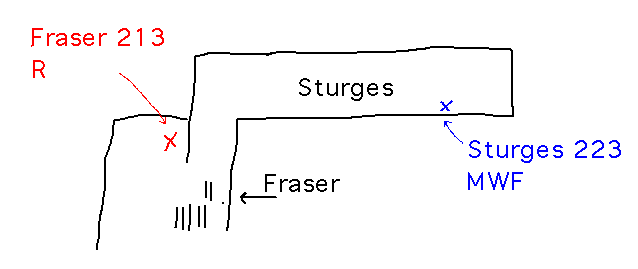Misc
Math 101
Formally “Welcome Mathematics Majors,” i.e., seminar introducing 1st-year, 1st-semester, math majors to the major, faculty, college, etc.
1 credit, very low workload
Meets Thursdays at 4:00
Strongly consider adding it if you’re a 1st-year, 1st-semester math major not already in it.
Questions?
Laptops are fine in class, required for some classes
Required technology is muPad (Matlab)
Syllabus
Questions
What books, supplies, etc. do you need for this course, and where do you get them?
The required textbook is OpenStax Calculus 1, available free online or not free from bookstore
Also Matlab / muPad, free at software.geneseo.edu
In this course, a numeric grade of 70% on a problem set, exam, etc. corresponds to roughly what letter grade?
B. There’s an unusual grading scheme
What rules limit things you can do while working on and turning in a problem set for this course?
No calculators on homework except when permitted, but you can use them on tests.
You can help each other and use outside sources, but cite sources/helpers.
Notation matters somewhat.
10% / day late penalty. Intention is that you shouldn’t turn things in late, but if you have to you’re better off turning them in than not.
Extra credit for “real world calculus.”
In what, if any, ways does the syllabus reflect the ideas about learning we talked about on Monday?
The collaboration policy encourages you to learn from each other.
The calculator rule gets you more deeply engaged in doing math than you otherwise might.
Office hours are flexible in order to encourage asking questions or seeing me for any other reason.
Summary
By and large, these problems steered you to features of my syllabus that I expect to be different from what you see in other courses.
- All materials for this course are free to you and available online. But you have to go find them, and soon.
- My approach to grades is very unconventional, and may be shocking at first, but it’s simpler and fairer to manage than more conventional schemes, and leads to the same long-term results.
- Some of the rules re problem sets (e.g., no calculators, correct terminology) may trip you up at first, but will probably get sorted out quickly.
The last problem, about connections to Monday’s discussion, hopefully reminds you that things don’t happen in isolation, they are connected and have reasons.
Next
The big questions behind calculus
Read chapter 2 introduction and section 2.1
When and where will this class meet?
- Regular time (11:30 - 12:20), but in Fraser 213
